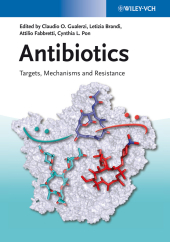 Neuerscheinungen 2013Stand: 2020-01-07 |
Schnellsuche
ISBN/Stichwort/Autor
|
Herderstraße 10
10625 Berlin
Tel.: 030 315 714 16
Fax 030 315 714 14
info@buchspektrum.de |

Letizia Brandi, Attilio Fabbretti, Claudio Gualerzi, Cynthia Pon
(Beteiligte)
Antibiotics
Targets, Mechanisms and Resistance
Herausgegeben von Gualerzi, Claudio; Brandi, Letizia; Fabbretti, Attilio; Pon, Cynthia
1. Auflage. 2013. 576 S. 30 Farbabb. 244 mm
Verlag/Jahr: WILEY-VCH 2013
ISBN: 3-527-33305-3 (3527333053)
Neue ISBN: 978-3-527-33305-9 (9783527333059)
Preis und Lieferzeit: Bitte klicken
Most of the antibiotics now in use have been discovered more or less by chance, and their mechanisms of action have only been elucidated after their discovery. To meet the medical need for next-generation antibiotics, a more rational approach to antibiotic development is clearly needed.
Opening with a general introduction about antimicrobial drugs, their targets and the problem of antibiotic resistance, this reference systematically covers currently known antibiotic classes, their molecular mechanisms and the targets on which they act. Novel targets such as cell signaling networks, riboswitches and bacterial chaperones are covered here, alongside the latest information on the molecular mechanisms of current blockbuster antibiotics.
With its broad overview of current and future antibacterial drug development, this unique reference is essential reading for anyone involved in the development and therapeutic application of novel antibiotics.
Preface
A CHEMIST´S SURVEY OF DIFFERENT ANTIBIOTIC CLASSES
Introduction
Aminoglycosides
Beta-Lactams
Linear Peptides
Cyclic Peptides
Thiazolylpeptides
Macrolactones
Ansamycins-Rifamycins
Tetracyclines
Oxazolidinones
Lincosamides
Pleuromutilins
Quinolones
Aminocoumarins
ANTIBACTERIAL DISCOVERY: PROBLEMS AND POSSIBILITIES
Introduction
Why Is Antibacterial Discovery Difficult? The Problems
Target Choice: Essentiality
Target Choice: Resistance
Cell Entry
Screening Strategies
Natural Products
Computational Chemistry, Virtual Screening, Structure- and Fragment-Based Drug Design (SBDD and FBDD)
Conclusions
IMPACT OF MICROBIAL NATURAL PRODUCTS ON ANTIBACTERIAL DRUG DISCOVERY
Introduction
Natural Products for Drug Discovery
Microbial Natural Products
The Challenge of Finding Novel Antibiotics from New Natural Sources
Workflow for Drug Discovery from Microbial Natural Products
Antimicrobial Activities: Targets for Screens
Natural Products: A Continuing Source for Inspiration
Genome Mining in Natural Product Discovery
Conclusions
ANTIBIOTICS AND RESISTANCE: A FATAL ATTRACTION
To Be or Not To Be Resistant: Why and How Antibiotic Resistance Mechanisms Develop and Spread among Bacteria
Bacterial Resistance to Antibiotics by Enzymatic Degradation or Modification
Antibiotic Target Alteration: The Trick Exists and It Is in the Genetics
Efflux Systems
The Case Stories of Intrinsic and Acquired Resistances
Strategies to Overcome Resistance
FITNESS COSTS OF ANTIBIOTIC RESISTANCE
Introduction
Methods to Estimate Fitness
Factors Affecting Fitness
Mechanisms and Dynamics Causing Persistence of Chromosomal and Plasmid-Borne Resistance Determinants
INHIBITORS OF CELL-WALL SYNTHESIS
Introduction
MraY Inhibitors
Lipid II Targeting Compounds
Bactoprenol Phosphate
Conclusions
INHIBITORS OF BACTERIAL CELL PARTITIONING
Introduction
Bacterial Cell Division
Cell Division Proteins as Therapeutic Targets
Status of FtsZ-Targeting Compounds: From Laboratory to Clinic
Conclusion
THE MEMBRANE AS A NOVEL TARGET SITE FOR ANTIBIOTICS TO KILL PERSISTING BACTERIAL PATHOGENS
Introduction
The Challenge of Treating Dormant Infections
Discovery Strategies to Prevent or Kill Dormant Bacteria
Why Targeting the Membrane Could Be a Suitable Strategy
Target Essentiality and Selectivity
Multiple Modes of Actions
Therapeutic Use of Membrane-Damaging Agents against Biofilms
New Approaches to Identifying Compounds That Kill Dormant Bacteria
Challenges for Biofilm Control with Membrane-Active Agents
Potential for Membrane-Damaging Agents in TB Disease
Application to Treatment for Clostridium difficile Infection
Is Inhibition of Fatty Acid/Phospholipid Biosynthesis Also an Approach?
Concluding Remarks
BACTERIAL MEMBRANE, A KEY FOR CONTROLLING DRUG INFLUX AND EFFLUX
Introduction
The Mechanical Barrier
Circumventing the Bacterial Membrane Barrier
Conclusion
INTERFERENCE WITH BACTERIAL CELL-TO-CELL CHEMICAL SIGNALING IN DEVELOPMENT OF NEW ANTI-INFECTIVES
Introduction
Two-Component Systems (TCSs) as Potential Anti-Infective Targets
WalK/WalR and MtrB/MtrA: Case Studies of Essential TCSs as Drug Targets
Targeting Nonessential TCS
Non-TCSs Targeting Biofilm Formation and Quorum Sensing in Pseudomonas spp.
Conclusions
RECENT DEVELOPMENTS IN INHIBITORS OF BACTERIAL TYPE IIA TOPOISOMERASES
Introduction
DNA-Gate Inhibitors
ATPase-Domain Inhibitors
Simocyclinones, Gyramides, and Other Miscellaneous Inhibitors
Conclusions and Perspectives
ANTIBIOTICS TARGETING BACTERIAL RNA POLYMERASE
Introduction
Antibiotics Blocking Nascent RNA Extension
Antibiotics Targeting RNAP Active Center
Antibiotics Blocking Promoter Complex Formation
Inhibitors Hindering Sigma-Core Interactions
Inhibitors with Unknown Mechanisms and Binding Sites
Conclusions and Perspectives
INHIBITORS TARGETING RIBOSWITCHES AND RIBOZYMES
Introduction
Riboswitches as Antibacterial Drug Targets
Ribozymes as Ant


